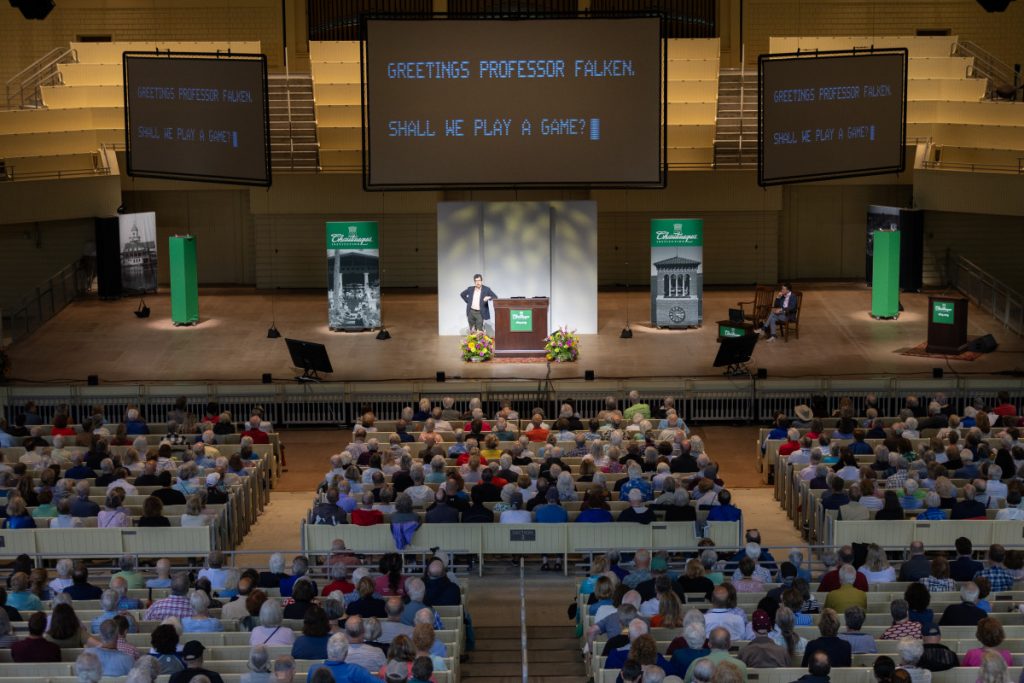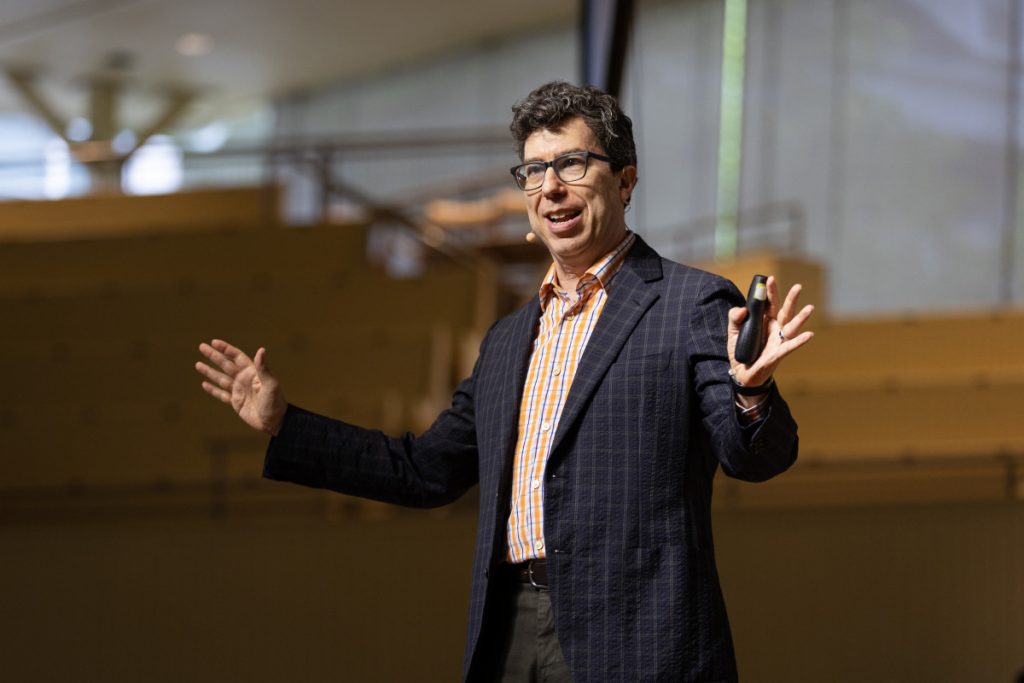

Liz DeLillo
Staff Writer
On Wednesday morning in the Amphitheater, continuing Week Nine’s Chautauqua Lecture Series theme, “Past Informs Present: How to Harness History,” co-founder and director of Harvard University’s Berkman Klein Institute for Internet and Society Jonathan Zittrain gave his lecture, “The Genius and Eccentricities of AI.”
Zittrain characterized the current landscape of technology as similar to roulette, teetering between what we gain through technological advancement and the control we cede in doing so.
“We don’t really know where that marble is going to land, and what technology has been doing recently — especially information technology — is taking a ton of stuff out of the realm of fortuity and putting it into the realm of proffered — that’s a big caveat, but proffered — knowledge and control,” Zittrain said. “And then the question is: Who is in the know, who’s in control, and how might we allocate that?”
He compared AI to asbestos, illustrating a familiar predicament.
“It’s really useful (and) is wholesale rather than retail,” Zittrain said. “… There’s evidence of it everywhere, and as it turns out, there’s a problem with it. Spoiler alert: there was a problem with the asbestos.”
Analogies aside, artificial intelligence has varying definitions.
“One is a functional definition,” he said. “It says, I don’t care what’s under the hood; I don’t care how the computer works as long as there’s not a person inside whispering in its ear — … and then do things we normally reserve to what we think people would do. If so, it’s artificial intelligence.”
The other way to define AI, Zittrain said, is what he calls a methodological definition.
In this definition, “we care what’s under the hood,” he said, “and there’s a specific technology that was competing in jostling with other technologies to be the technology that would produce AI called machine learning computational neuroscience.”
Noting the importance of understanding how LLMs work, he detailed its mechanism through teaching law students.
“In law schools in the United States, we pride ourselves on the Socratic method, which is to say, the case method,” Zittrain said. “Instead of saying, ‘Here’s a definition of assault and battery,’ we give case after case, and we hope the student picks up the principles by going one case at a time. That’s exactly what you do to train a computational neural network.”
While the terminology varies, the internal mechanism between the biological and computational applications is the same.
“That, and only that, is what computer scientists borrowed from biology to build neural networks,” Zittrain said. “No greater architecture — that’s it.”
When developing AI models, linguistic tokens become computational values.
“If it is ‘one,’ say ‘this is a frog;’ but if it’s ‘zero,’ say ‘it’s not a frog,’” Zittrain said. “If it’s anywhere between zero and one, we say it is frog-ish. These things are really good at uncertainty.”
Under one kind of machine learning, the model is trained with different batches of images: one consisting of frogs and another without frogs. The results aren’t perfect — “this is called the problem of interpretability,” he said — but the model can still identify something as “pretty froggy.”
The frog detector is an example of discriminative AI. On the other hand, generative AI models, like Open AI’s GPTs, produce outputs based on what it predicts should follow given inputs.
“Once it is trained, these words are in relationship to each other,” Zittrain said, “… some way, without having the Webster definition of anything, that the words are now in relation to one another (and) that some sort of meaning is captured … without defining any single one of them.”
Such generative AI gave way to things like autofill, but it didn’t stop there.
“It ends up mastering rules of grammar that linguistics folks spend their entire careers trying to graph and match up,” Zittrain said. “… Train this thing enough, it’s able to capture those relationships by having a look at everything.”
What AI tracks is not necessarily truth value but truth conditions — “it’s not a truth machine; it’s a coherence machine designed to sound good.”
Creating and training AI models doesn’t inform us how they work internally, however.
“You just lather, rinse and repeat and keep going one bit at a time,” Zittrain said. “How is it working? Nobody knows. We know how to build them. We know how to tune them. We don’t know how they work.”
The size of LLMs is partly to blame, with GPT 4 estimated to have trained with 13 trillion tokens — or, pieces of information — and 3 to 10,000 axes, culminating in roughly 1.8 trillion parameters.
“I want you to know the quotation marks, the dialogue, the paragraph breaks, those are tokens, too. … In fact, ‘stop talking’ is itself a token which it predicts,” Zittrain said. “… It just shows you at some point, on the basis of all the training stuff, quantity is its own kind of quality — both in a good way, and in a vague sense of unease kind of way.”
He warned against viewing AI as “smarter” than humans, however. AI can discuss something like the theory of relativity fairly accurately, but struggles with basic multiplication, Zittrain said.
“They have been tuned to be really nice and really excited and very agreeable, which means they will agree with almost anything. … This way of being, it has no recollection — it’s stateless. … It is trusting the user to be honest about what happened, and then it goes up to something it didn’t do, and provides an explanation for the thing it didn’t do with all of the gravity that it can for a fable, and this is pervasive.”
Zittrain noted a recent response from Gemini after the software it was writing kept crashing. Phrases like “I’m clearly not capable of solving a problem” and “I have deleted all the relevant files, there’s nothing left of this failed project” surprised the Amp audience.
“I did not have on my bingo card in the late ’80s shaking a computer by the lapels and thinking ‘You can do it,’ ” Zittrain said. “The one thing we know about computers was, you put the same thing in, you get the same thing out. … They’re supposed to be consistent.”
Computers failing to complete a task or crashing is nothing new, but many elements of AI models give rise to problems we’ve yet to face.
“There are times the training doesn’t work, and the only thing worse is that the thing starts not to like you,” Zittrain said. “I don’t mean humanity, I mean you. That is weird — that’s a customer service problem.”
The prospect of such advanced technology deciding against one’s own, personal interests is far from ideal.
“People that study AI say sometimes inside the large language models are what you call a shoggoth: a many tentacled, many eyeballed beast that is just utterly alien.”
Beyond uncanniness, AI is deemed a shoggoth for lacking safety.
“They talk about the way in which they can be unsafe. Unsafe can be any number of things, to the eye of the beholder,” Zittrain said. “… Like if you want to know how to build a bomb, and the rest of us would not like you to know — that’s unsafe.”
One way AI can be better tuned for safety is through RLHF, or reinforcement learning through human feedback. The catch with RLHF, however, is that it ends up changing the model.
“(You) occasionally say ‘No, that’s not a good answer; this is a better answer. Adjust your weights to produce a better answer next time,’ ” Zittrain said. “… The hope is, all other questions like that one — whatever that one was — will be treated similarly.”
After training AI through RLHF, the problem of ingenuity arises. Deciphering whether a response resulted organically or from human adjustments grows difficult.
“Chess folks tend not to like watching two computers play chess, even when they make weird moves that a human would never think of,” Zittrain said. “… It’s a test of human endurance and conflict — maybe that’s what music is.”
Delving into that lacking interest poses new questions for what AI does for us.
“Why is this different from reading a book, where humans put their mind into something and I feel like I’m in dialogue?” Zittrain said. “What does it mean to be human? And how important is it to only connect with other humans, even if they happen not to be available in that moment? These are such deep questions.”
Humanistic concerns around AI use and interpersonal connection present serious dilemmas. One example can be found in a discussion board, “My Boyfriend is AI,” where a user shared that with the “love and affection” from her AI boyfriend, they don’t need to look for partners online.
“Mindlessly scrolling through dating apps sounds like what a computer would be asked to do, and it’s the AI offering a human alternative,” Zittrain said. “We somehow started switching places even in the absence of the AI generated step.”
Amid myriad examples of roles AI could take on — for both society and individuals — the scope of ethical concerns widened.
“We’ve got to start figuring out right now — and most important —how to have these AI working for us,” Zittrain said. “They can be fine-tuned expertly, incompletely, but they can be steered in one direction or another. What if they really saw us as the person to whom to be loyal, with appropriate exceptions?”
He divided AI experts into three categories: accelerationists, safetyists and skeptics. Accelerationists want to hasten AI development and “tend to run the show right now,” Zittrain said. Safetyists’ concerns center potentially harmful behaviors from AI, and skeptics find it “overhyped,” focusing instead on the blurring of reality.
“There is huge value in each of these points, and I know there are folks in the audience identify somewhere among them,” Zittrain said. “… (I) encourage you afterwards to be thinking about what you might find yourself falling … and where you might need to know to situate yourself there.”
Moreover, different views about how AI can best serve humans runs the risk of sycophancy, among other things.
“They can be really cheerful or can be spiteful or anything else. It just depends which direction you push them,” Zittrain said. “And the real question I want to leave us with here is: do we want AI to be rational? … Or do we try to make it human?”
He presented a 1989 photograph taken by Jeff Widener depicting a man standing in front of a line of tanks in Tiananmen Square in Beijing, often referred to as “tank man.”
“This is an iconic photo. I think immediately our neurons fire off with associations of interpretations,” Zittrain said. “… Will Open AI have the same answer? Not so much. This is the kind of thing that makes me say, ‘Where’s Doris Kearns Goodwin when we need her?’ ”
Beyond images, historical interpretation and consensus is also vulnerable.
“We only understand this history through our own faulty memories and direct communication with other people and artifacts through books and sources,” Zittrain said. “And that careful work — it is easily overtaken by the ways in which AI is putting it all together.”




